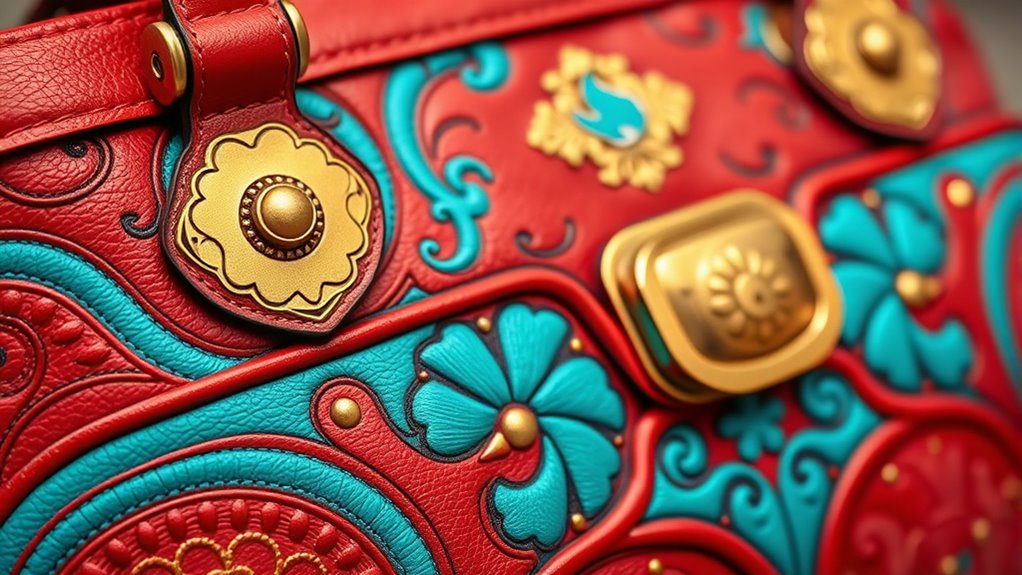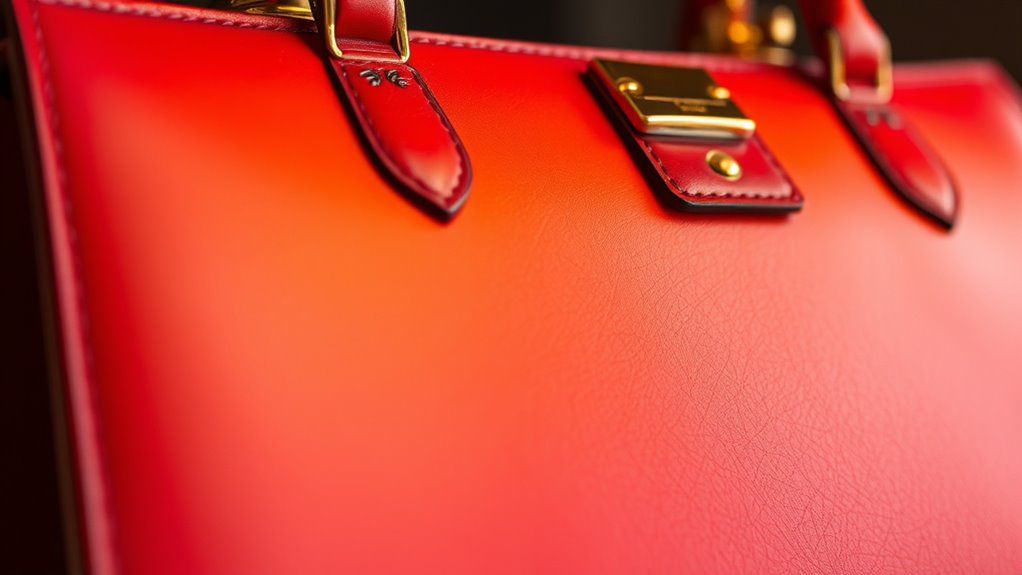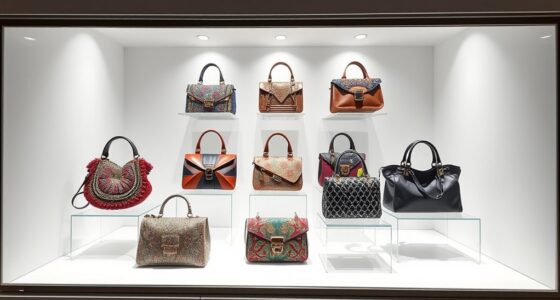Colors in handbag design carry deep cultural meanings that influence how others perceive you. For example, black often symbolizes elegance in Western cultures, while red can represent luck and celebration in Eastern societies. White may suggest purity but also mourning, depending on the context. Gold signals wealth across many cultures. Understanding these nuances helps you choose colors that align with your message and values. Keep exploring to discover how to balance style and cultural significance effortlessly.
Key Takeaways
- Different cultures assign unique meanings to handbag colors, influencing design choices and consumer preferences.
- Black handbags symbolize elegance in Western cultures, while red represents luck and celebration in Eastern societies.
- White handbags often denote purity in Western fashion but may be associated with mourning in some Eastern cultures.
- Gold signifies wealth and luxury across many cultures, enhancing a handbag’s status and appeal.
- Cultural awareness ensures handbag colors communicate appropriate messages and respect cultural symbolism.

Colors play an essential role in handbag design, influencing how a bag complements your style and makes a statement. When choosing a handbag, you’re not just considering its shape or size, but also the colors that carry deeper meanings rooted in cultural symbolism. Different hues evoke specific associations across cultures, which can profoundly impact how others perceive your accessory. For instance, in many Western cultures, black is associated with elegance, sophistication, and formality, making it a popular choice for evening bags. Meanwhile, in some Eastern societies, red symbolizes luck, prosperity, and celebration, so a red handbag might be chosen to bring good fortune or to mark special occasions. Understanding these cultural nuances allows you to select bags that resonate with your personal values or cultural background, adding another layer of significance to your accessory.
Color psychology also plays a fundamental role in handbag design, shaping how you feel when carrying a particular color and how others respond to it. For example, wearing or carrying a bright yellow bag can evoke feelings of happiness and optimism, while a deep blue might project calmness and trustworthiness. When you select a handbag based on color psychology, you’re intentionally influencing your mood and the impressions you leave. A vibrant, bold-colored bag can communicate confidence and creativity, whereas softer pastel shades may convey approachability and subtlety. Recognizing the emotional responses associated with different colors helps you make more meaningful choices that align with your intentions or the message you want to send.
Additionally, understanding the cultural significance of colors can help you avoid unintended connotations and make more thoughtful selections that respect diverse perspectives. The interplay between cultural symbolism and color psychology makes handbag color selection a nuanced decision. You might choose a color that not only fits your personal style but also aligns with the cultural meanings that enhance the handbag’s message. For example, a white handbag in Western fashion often symbolizes purity and simplicity, but in some Eastern cultures, white is associated with mourning. Being aware of these differences ensures you avoid unintended connotations. Similarly, understanding that gold signifies wealth and luxury across many cultures can influence your choice when aiming to project status or elegance.
Ultimately, the colors you pick for your handbag carry more than just aesthetic appeal—they embody cultural stories and psychological influences that shape perceptions. By considering both cultural symbolism and color psychology, you can select handbags that not only match your outfit but also communicate your personality, beliefs, and mood. Whether you want to make a bold statement or keep things subtle, understanding these deeper meanings empowers you to make more conscious and impactful fashion choices.
Frequently Asked Questions
How Do Cultural Differences Influence Color Choices Globally?
You should understand that cultural differences considerably influence your color choices, as cultural color symbolism varies around the world. For example, red symbolizes luck in China but signifies warning in Western countries. By considering global fashion influences, you can create handbags that resonate with diverse markets. Adapting your designs to reflect different cultural meanings helps guarantee your products appeal universally and respect local traditions.
Are There Specific Colors Associated With Certain Social Statuses?
You’ll notice that certain colors often symbolize social status through color symbolism, with some hues associated with wealth or power. For example, deep purple or gold can signify luxury and high social standing, while simpler colors like black or brown might be more common among everyday styles. By choosing specific colors, you can subtly communicate your social status, making your handbag a statement piece that reflects your position or aspirations.
How Do Color Trends Evolve Across Different Cultures?
Imagine you’re in a time machine, jumping from the Renaissance to modern streets—color trends evolve as societies change. You’ll notice that color symbolism and fashion psychology influence these shifts across cultures. Bright reds might symbolize luck in China, while in Western cultures, they often denote passion. As global influences grow, color trends adapt, blending tradition with innovation, making each culture’s palette unique yet interconnected.
Can Color Symbolism Impact Handbag Resale Value?
Color symbolism can definitely impact your handbag’s resale value. When you understand color psychology, you choose shades that appeal broadly and evoke positive emotions, increasing desirability. Additionally, strong brand recognition tied to specific colors boosts perceived value, attracting collectors and fashion enthusiasts. By selecting colors with favorable symbolism and aligning with popular brand identities, you enhance your handbag’s market appeal and resale potential.
Do Cultural Taboos Affect Color Selection in Handbag Design?
Think of color superstitions as your handbag’s secret code. Cultural color codes influence your choices, and taboos can definitely affect your design decisions. You wouldn’t want to wear a white dress to a Chinese wedding, just like you shouldn’t choose red for a somber event in some cultures. These taboos help you respect traditions, ensuring your handbag design resonates positively and avoids unintended cultural offenses.
Conclusion
As you pick your handbag’s color, remember it’s more than just a shade—it’s a story waiting to be told. Like a painter’s brushstroke, each hue paints a different emotion and cultural message, turning your accessory into a vibrant conversation piece. So trust your instincts and choose a color that speaks to your soul. After all, your handbag isn’t just an accessory; it’s a colorful mirror of who you are, shining brightly in your unique story.









